In recent years, roughly 800 annual roadside fatalities have occurred across the United States due to snow and ice. Driving in such conditions is incredibly dangerous, and most car owners don’t read up on winter driving tips. A lot of drivers go through a learning curve at the outset of each winter as the challenges of inclement weather make it far less safe to operate a vehicle than usual.
To be safe on the road during the cold months, read up on tips for driving in snow and ice. If you do have an accident, you should know what kind of auto insurance will cover the ensuing costs. This article covers various driving tips for winter and how to prepare for the challenges as well as some winter car insurance tips. If you plan to put your car away for several months, the section on winter car storage goes over ways to keep the vehicle protected while it remains idle.
Jump To:
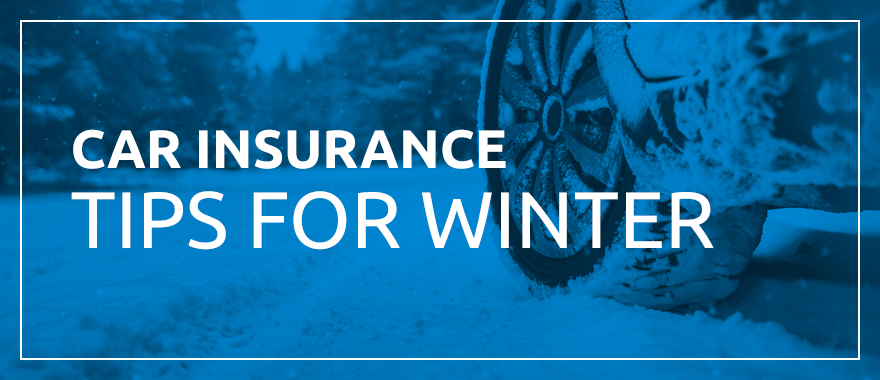
With the following winter car safety tips, you can ensure you’ve equipped your vehicle for challenges on the road:
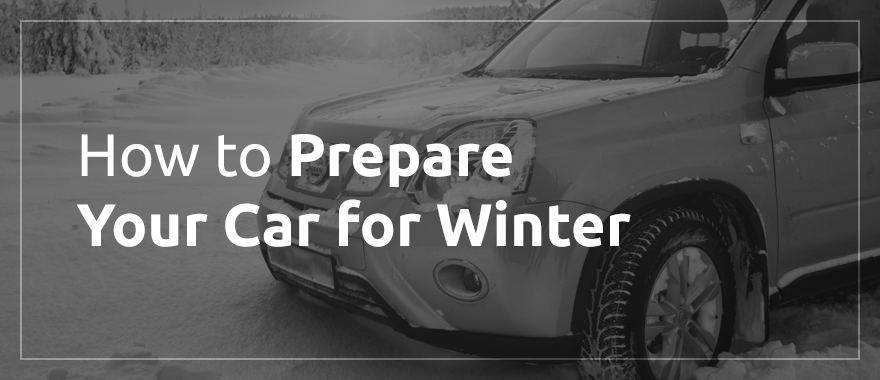
Keep your tank as full as possible during winter months. As inclement weather approaches, you can never be too sure about access to nearby gas stations. In a matter of hours, the streets in your area could wind up being piled with snow, making the trek too dangerous if not outright impossible.
With a full tank of gas, you will be prepared for the smaller amounts of driving that you may need to do both before and after a snowstorm. If you need to run out quickly to stock up on consumables and blankets before an expected power outage, you can get to the store and back without having to bear long lines at nearby fuel stations. A full tank of gas will also help prevent the formation of frozen matter within your vehicle’s fuel lines.
The condition of your tires is integral to the performance of your car, especially during wintertime. Your tires must have proper air pressure at all times to roll and support your vehicle properly. Likewise, the rubber must have healthy tread to keep adequate traction with the pavement.
If the treads on your tires are wearing down as winter approaches, replace those tires. Make sure to only buy tires from the same source to ensure the proper balance of your vehicle. For best results, replace all the tires on your vehicle at the same time, as this will ensure an even tread and balance across all four wheels.
When it comes to air pressure, cold temperatures are one of the primary litmus tests. Your tires could lose pressure more easily if the weather in your area drops to the subzero level. Check the pressure of your tires more frequently in the colder months, preferably once each week.
Depending on the winter weather patterns in your area, you might need to install snow tires on your vehicle. If snow and ice are regular occurrences in your area between November and February, snow tires would better serve your vehicle. Even with a set of rugged year-round tires, the textures of snow, ice and rock salt can take their toll on rubber, and it’s not worth accelerating the wear and tear on a good set of regular tires.
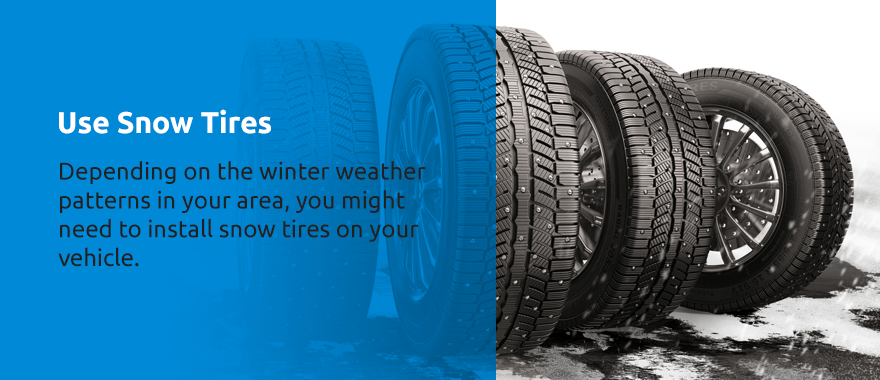
If you don’t expect snow in your area, snow tires are still advised if you plan to travel by vehicle to a snowy part of the country in the winter months. The laws on snow tires vary from state-to-state, so check with your state’s DMV to see which months you can legally have snow tires on your vehicle. In Missouri, studded tires are prohibited between April 1st and November 1st.
As winter approaches, take your car into your trusted local service station to have a tune-up and an oil change. This is also a good time to inspect the fluid levels in your engine compartments. Make sure the antifreeze is fresh and in ample supply, and top off the windshield wiper fluid. If either runs too low, they could get sludgy in subzero weather and fail your vehicle when you need them most. For backup protection, keep spare supplies of antifreeze and cleaning fluid in your trunk throughout winter.
Make sure that all of the lights on your vehicle are in optimal working condition. During winter, daylight is shorter, and lights are a necessity during more hours of the day and evening. In times of fog, snow and intense downpour, lights are even crucial in the broad daylight.
If your vehicle lacks fog lights yet fog is prevalent in your area during wintertime, have fog lights installed on your vehicle. The yellow of fog lights is more effective at cutting through the visually dense murk of fog. Do not rely on brights as they are no substitute.
If you install new headlights yourself, make sure that they are correctly aligned. If the lights are too high, they could momentarily blind oncoming motorists and cause roadway dangers.
When you are out on the road, and the weather gets rough, unpredictable things can happen. If you suddenly find yourself in a situation where you are stuck for several hours, you’ll need to have non-perishable food on hand and some warming supplies to get you through the adventure.
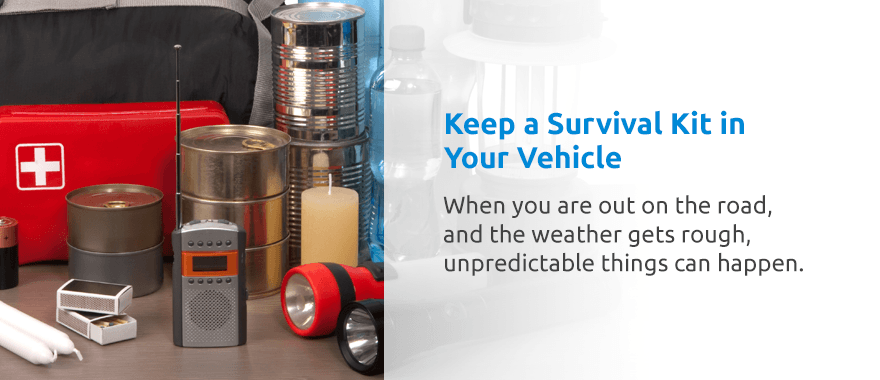
If your vehicle gets stuck in the snow or fails to start when you’re away from home, you should also have instruments on hand to help you out of these situations. Keep the following supplies in your vehicle throughout the winter months:
If possible, you should also have a smartphone on hand with an active WiFi account so you are never without contact with the outside world. Also, keep the owner’s manual for your car in the glove compartment at all times.
The following driving tips for winter can help keep you safer behind the wheel when you head out during inclement weather:

If and when you must drive your car under severe weather conditions, you should always approach such outings with extra degrees of preparedness. Before you head out the door, plan your route in advance. Choose the safest way to a given destination, even if the course in question is twice as long as the expressway.
Wintertime is no time for aggressive driving or idle cruising, especially not when storm clouds advance or when the forecast calls for rainstorms, snow or hail. Drive slowly, cautiously and defensively each time you head out, especially after dark. Stay away from dark, unlit roads and try to steer clear of underpasses, steep hillsides and narrow two-lane/two-way streets and bridges.
If you are going out to meet another party, contact them before heading out to let them know approximately when they should expect you to arrive. If you have a cell phone, keep it fully charged and on you the whole time, but never use it while you are driving. Talking or texting while driving is dangerous enough in normal conditions and the dangers are only compounded by harsh winter weather.
In the normal light of a clear day, it is unlawful to drive at sluggish speeds below the speed limit. In snowy, fog-bound winter conditions, however, slow driving is safe and often standard on roadways. Chances are, the cars along boulevards and highways will be driving at slower speeds when inclement weather hits your area, especially during nighttime.
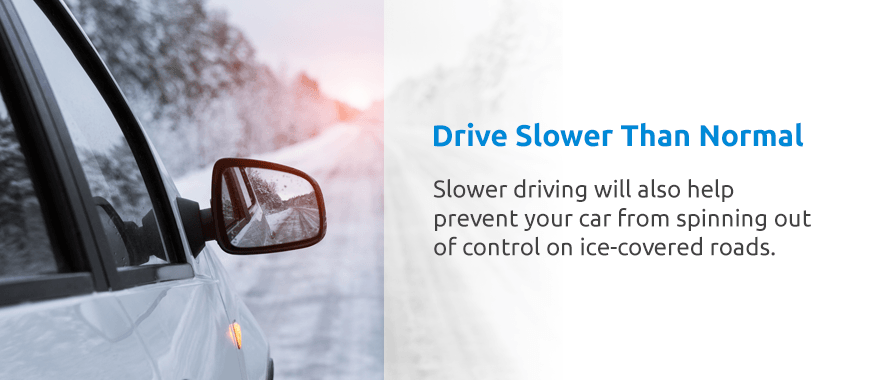
Keep your driving pace slow in harsh winter conditions, as this will give you time to brake if the traffic ahead of your vehicle comes to an abrupt halt. Preferably, you should maintain a three-car distance at all times from fellow vehicles on the roadways. Slower driving will also help prevent your car from spinning out of control on ice-covered roads.
When you drive your vehicle along ice-laden and snow-covered roads, you stand a greater chance of skidding out. To prevent this from happening, go light on your pedals. As you increase the speed of your vehicle, do so slowly. Abrupt speed increases could cause your tires to lose traction with the slippery road. The same applies when you brake your vehicle, as sudden stops are a lot more difficult on your tires in traction-challenged conditions.
For maximum safety, avoid situations that might require you to brake your car abruptly. Never trail other vehicles too closely and always drive extra slowly when the traffic is dense.
In harsh winter driving conditions, you’ll sometimes have to cope with slow situations, such as when you find yourself inching along behind a snowplow. While it is true that snowplows move slowly, they do so because it is necessary to plow away the snow that lies ahead on the road. Therefore, it is pointless to pass a snowplow as the road ahead would be obstructed with snow that the plow would have yet to clear away. In a sense, you would be lucky to find yourself behind a snowplow rather than in front of one because the plowed pavement is easier on your tires.
It can also be dangerous to pass a snowplow because drivers of these vehicles have blind spots and often cannot see passing motorists. By gunning your car to pass the snowplow, you could easily spin out of control due to the icy road conditions. Even if you manage to pass the snowplow, the situation ahead could be even more dangerous.
There are times when you simply shouldn’t drive and others when you need to employ winter driving safety precautions:
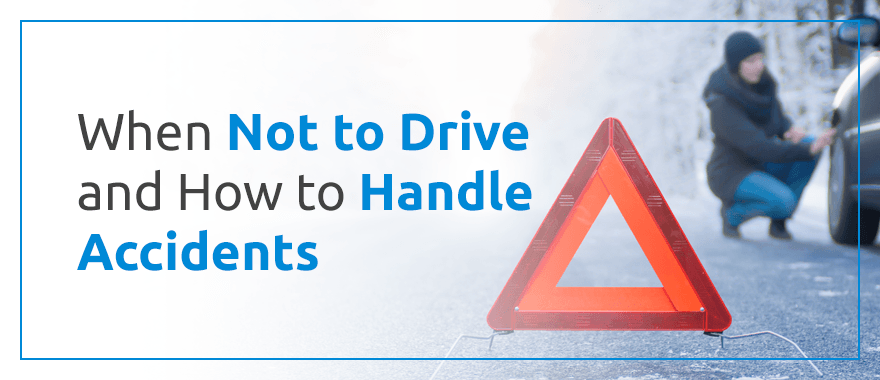
If the roads are closed in your area, keep your vehicle off the road. If you do need to step out for food or supplies, try to make the trek by foot. When local authorities close roads, they do so to protect motorists from unsafe driving conditions. If you take your car out on closed roads, there is a higher likelihood that it will spin out of control or slide into a snow ditch, even if you drive slowly with snow tires on the vehicle.
You could also find yourself financially strapped if you have an auto accident on a closed road. Regardless of your level of auto insurance coverage, you might be denied by your insurer if your vehicle gets damaged or totaled on a closed road. Insurance companies will often accuse such drivers of contributory negligence and deny claims over accidents that occur in these conditions.
In harsh weather conditions, one of the biggest dangers to your vehicle could be nature itself. If a tree is struck down in a snow or lightning storm and the trunk crashes down over your vehicle, you will need to have a comprehensive auto insurance policy to cover the damage.
Only with comprehensive insurance will cover you for the repair expenses or replacement costs of a damaged or totaled vehicle. If you just have a basic liability insurance policy, you won’t be covered for damages incurred on your vehicle by acts of nature. Thankfully, comprehensive coverage can be a relatively inexpensive addition to auto insurance as long as you maintain a clean driving record.
Your likelihood of an accident is increased if you drive in winter conditions. Even if you stick to streets that appear relatively clear of snow or ice and several days have passed since the last storm, there could still be traces of ice on the road that could cause your car to slide. If you lose control of your car and it hits a building, you won’t have much to worry about as long as no people are injured.
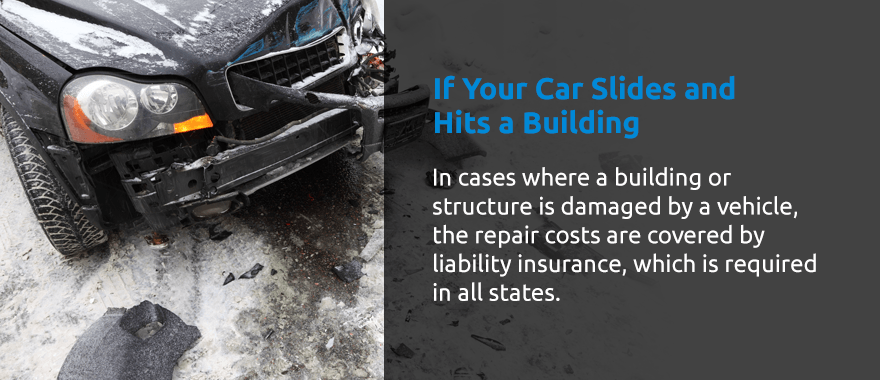
In cases where a building or structure is damaged by a vehicle, the repair costs are covered by liability insurance, which is required in all states. For example, if you accidentally crash through someone’s residential fence, garage or store window, the aggrieved party can simply file a liability claim on your insurance, and your insurer will pay for the repair costs. If your own vehicle comes out unscathed, you usually don’t need to do anything else as everything is taken care of between the claimant and insurer.
If your car slides and hits a parked car, van or truck, the owner of that vehicle can file a claim on your insurance to cover his or her repair costs. As long as the limits to your liability policy are high enough to cover the costs, you shouldn’t be required to pay anything out of pocket. However, the law requires that you leave a note on the windshield of the damaged vehicle, complete with a description of the incident and information on who to contact. Failure to perform this action could disqualify you of liability coverage in the case at hand.
Whether snow-related damage is covered depends on your policy. Comprehensive insurance typically helps repair or replace damaged areas. Check with your provider for details on your specific coverage.
If you would rather store your car in the winter, follow these steps to ensure that the car remains in good shape throughout the cold season:
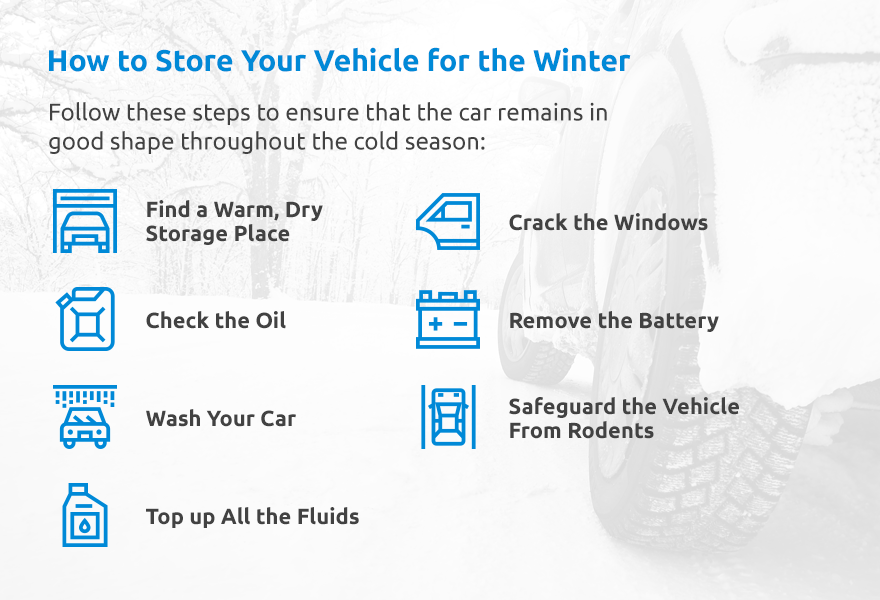
If you plan to store your car in the winter, keep it stored inside a safe, low-moisture storage space. A home garage is the best place to store a car. If you don’t have a garage, find an indoor vehicle storage facility and rent a spot for your car. A car should always be stored on a solid, concrete floor. Do not leave your car parked in a barn or under a covered area on top of grass or soil, as this would leave the vehicle’s underside exposed for a prolonged period to flora and fauna.
Before you put your car away for the winter, pull out the oil dipstick to check the level and quality of the current oil supply. If the level is low or the stick is dirty, change out the oil for a new supply. Modern synthetic oil can last in an engine for up to a year. If the oil is clean and plentiful, go ahead and wait until spring, then check the oil again.
Give your car a good, thorough exterior wash before you store it away for winter. This will rub off any bacteria and mold that could otherwise develop if left to grow during four or five months of storage time.
Fill up your car with gas, top it off with a fuel stabilizer and let the engine run for five minutes to circulate the fluid through the system. Also top up the antifreeze and windshield cleaning fluid.
Roll down the windows slightly to circulate air through the vehicle. This will prevent moisture from developing inside the car during the months it spends in storage.
If possible, remove the battery and store it someplace safe in your house, such as on a board with nearby access to a charger. If your car is equipped with one of those newer batteries that must stay put to maintain the vehicle’s memory, skip this step.
Rodents could make their way into your car during winter and chew critical wires. To prevent this from happening, place steel wool inside the air inlets and exhaust pipes.
As an added measure of precaution, place a plastic cover over the top of your vehicle. Choose a ventilated cover to ensure that the car can breathe during the time you leave the vehicle parked in storage.
Many of us like to warm up our cars on those frigid Missouri mornings — after all, who enjoys sitting in a freezing car waiting for the heater to crank up? But imagine this scenario — you brave the cold to go outside to start the engine, then head back in for one last cup of coffee while you wait. A few minutes later, you walk out the door — only to discover that your car isn’t there!

This type of car theft occurs much more often than you think — recently, police responded to 16 reports of “car warmup thefts” in St. Louis County alone. The following tips can prevent you from becoming the next victim of car thieves who target running vehicles:
While it might sound obvious, never leave your doors unlocked while the vehicle is running — even it if means carrying an extra set of keys. Many car warmup thefts occur when the crook sees a vehicle with smoke coming out of the exhaust. They can easily walk up, open the door, get in and drive away. There is no “safe” place to leave a running vehicle with the doors unlocked — including your own driveway.
Car thieves who target warming up vehicles often work as a team. They’ll patrol a neighborhood looking for a running, unoccupied vehicle. The driver then lets his cohort out so he can steal the auto and drives away. When you go out to warm up your car, keep a watch for suspicious-looking vehicles, especially slow-moving ones with multiple occupants.
The farther away from a house or building an automobile is, the more tempting it is for a thief to try to steal it. If possible, warm your car up in the driveway instead of at the curb. You could also use the garage, but don’t forget to leave the door open to reduce the risk of carbon monoxide poisoning from vehicle exhaust.
Make sure you can see the car through a window or other access point as it warms up. It doesn’t take long for experienced car thieves to get inside your vehicle and drive away. If you have to leave the room, ask someone else in the house to keep watch until you return.
Use all the modern technology that your vehicle has to offer to prevent car theft. Depending on the make, model and year, your vehicle may be equipped with alarms and a variety of audio and visual deterrents.
If you do become the victim of a car warmup theft, your auto insurance coverage will go into effect. Make sure you carry comprehensive coverage — you’ll only have to pay the deductible, which is the amount you must pay out of pocket before your policy takes over. Report the car theft as soon as possible to your carrier and the police.
To face the winter driving conditions of the midwest roadways, you need to have car insurance that will protect you in many possible scenarios. Dave Pope Insurance provides coverage to vehicle owners throughout Missouri, Arkansas, Iowa, and Kansas. We have two offices conveniently located in St. Clair and Union. For more than 15 years, we’ve been the Missouri’s leading supplier of auto insurance. Contact Dave Pope today to get a free car insurance quote.
